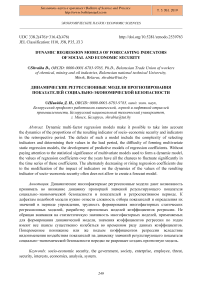Dynamic regression models of forecasting indicators of social and economic security
Автор: Shvaiba Dzmitry
Журнал: Бюллетень науки и практики @bulletennauki
Рубрика: Экономические науки
Статья в выпуске: 1 т.5, 2019 года.
Бесплатный доступ
Dynamic multi-factor regression models make it possible to take into account the dynamics of the proportions of the resulting indicator of socio-economic security and indicators in the retrospective period. The defects of such a model include the complexity of selecting indicators and determining their values in the lead period, the difficulty of forming multivariate static regression models, the development of predictive models of regression coefficients. Without paying attention to the statistical significance of multivariate models used to form a dynamic model, the values of regression coefficients over the years have all the chances to fluctuate significantly in the time series of these coefficients. The alternately decreasing or rising regression coefficients due to the modification of the impact of indicators on the dynamics of the values of the resulting indicator of socio-economic security often does not allow to create a forecast model.
Socio-economic security, government, society, enterprise, employee, threat, security, interests, economics, analysis, system
Короткий адрес: https://sciup.org/14115032
IDR: 14115032 | УДК: 338.2(476)+316.42(476) | DOI: 10.5281/zenodo.2539763
Список литературы Dynamic regression models of forecasting indicators of social and economic security
- Пузиков В. В., Гайдельцов В. С., Трухов В. А. Методы анализа и прогнозирования динамики показателей в оперативно-розыскной деятельности по обеспечению национальной безопасности Республики Беларусь. Минск: Ин-т нац. безопасности Респ. Беларусь, 2003. 245 с.
- Даурбеков С.-Э. С., Хадисов М.-Р. Б. Индекс качества жизни населения - индикатор экономической безопасности региона // Управление экономическими системами. 2015. №5. С. 10.
- Буркальцева Д. Д. Методология расчета и управления оптимизацией показателей экономической безопасности // Вестник Екатерининского института. 2014. №1. С. 12-18.
- Григорьева Е. А. Социально-экономические индикаторы экономической безопасности России // Актуальные проблемы экономики и права. 2014. №2. С. 19-24.
- Савина Т. Н., Федонина О. В. Формирование социально-ориентированной рыночной экономики с позиции обеспечения национальной экономической безопасности: возможности, проблемы, перспективы. Саранск: Принт-Издат, 2014. 192 с.
- Николаева А., Караханян К. Рационализация социальных взаимодействий в современном обществе // Путь науки. 2016. №8. С. 83-85.
- Кузьбожев Э. Н., Трухов В. А. Концепция формирования плана-прогноза социально-экономического развития региона. Сыктывкар-Гомель: СГУ, ГГУ, 1992. С. 34-37.
- Королев Ю. Г. Методы «дерева цепей» и прогнозного графа // Статистическое моделирование и прогнозирование. М., 1990. С. 255-257.
- Shvaiba D. Structural stability and socio-economic security of the hierarchical system // Бюллетень науки и практики. 2018. Т. 4. №6. С. 233-239. DOI: 10.5281/zenodo.1289852
- Shvaiba D. Socio-economic security of the hierarchical system // Бюллетень науки и практики. 2018. Т. 4. №6. С. 248-254. DOI: 10.5281/zenodo.1289862


